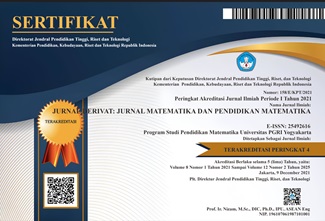Penerapan Model Pembelajaran Visualization, Auditory, Kinesthetic Terhadap Kemampuan Penalaran Matematis Siswa Smp
DOI:
https://doi.org/10.31316/j.derivat.v6i2.505Abstract
This study aims to determine the mathematical reasoning abilities, activities and motivation of students by applying the Visualization Auditory Kinesthetic (VAK) learning model. This type of experimental research with the design of the Nonequivalent Pretest-Posttest Control Group Design. The experimental and control classes were given a pretest and a posttest to see the difference in improvement between the two. The population in this study were students of class VIII and the sample was not chosen purely randomly, namely by cluster random sampling (random class) and two classes were chosen. Data analysis using statistical tests namely Mann Whutney U-Test and descriptive analysis in the form of a percentage formula and the average score. The results of data analysis show that: (1) There is a difference in the increase in students' mathematical reasoning abilities, and the increase in the experimental class is higher than the control class; (2) Student learning activities in each indicator are in the very high category and the overall average is 88.075%; (3) The average student motivation in each indicator is in the high category and the overall student average is 4.00.
Keywords: Visualization Auditory Kinesthetic, Reasoning, Activity, MotivationDownloads
Published
Issue
Section
Citation Check
License
Authors who publish with this journal agree to the following terms:
-
Authors retain copyright and grant the journal right of first publication with the work simultaneously licensed under a Creative Commons Attribution-ShareAlike 4.0 International License that allows others to share the work with an acknowledgment of the work's authorship and initial publication in this journal.
- Authors are able to enter into separate, additional contractual arrangements for the non-exclusive distribution of the journal's published version of the work (e.g., post it to an institutional repository or publish it in a book), with an acknowledgment of its initial publication in this journal.
- Authors are permitted and encouraged to post their work online (e.g., in institutional repositories or on their website) prior to and during the submission process, as it can lead to productive exchanges, as well as earlier and greater citation of published work (See The Effect of Open Access).







